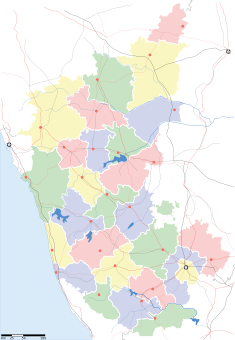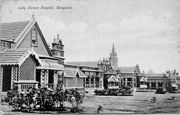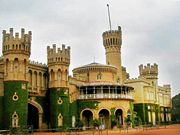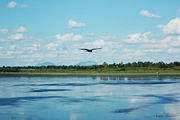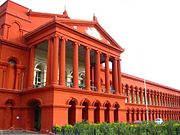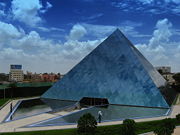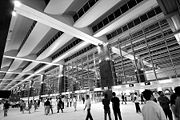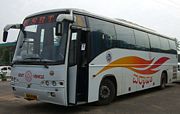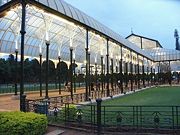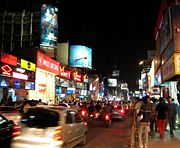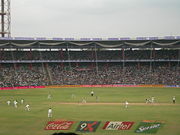Bangalore
2008/9 Schools Wikipedia Selection. Related subjects: Asia; Asian Cities
| ?Bangalore Bengalūru (ಬೆಂಗಳೂರು) Karnataka • India |
|
|
|
|
|
|
|
| Coordinates: | |
| Time zone | IST ( UTC+5:30) |
| Area • Elevation |
741 km² (286 sq mi) • 920 m (3,018 ft) |
| Region | Bayaluseeme |
| District(s) | Bangalore Urban |
| Population • Density |
6,200,000 ( 3rd) ( 2007) • 8,367 /km² (21,670 /sq mi) |
| Commissioner | Dr.S. Subramanya |
| Codes • Pincode • Telephone • UN/LOCODE • Vehicle |
• 560 xxx • +91-(0)80 • IN BLR • KA 01, KA 02, KA 03, KA 04, KA 05, KA 41, KA 50, KA 51, KA 53 |
Coordinates:
Bangalore, officially Bengaluru ( Kannada: ಬೆಂಗಳೂರು, ['beŋgəɭuːru] , Indian English: [ˈbæŋgəloːɾ] ), is the capital of the Indian state of Karnataka. Located on the Deccan Plateau in the south-eastern part of Karnataka, Bangalore is India's third most populous city and fifth-most populous urban agglomeration.
It is home to numerous public sectors such as heavy industries, software companies, aerospace, telecommunications, machine tools, heavy equipment, and defence establishments. Bangalore is known as the Silicon Valley of India owing to its pre-eminent position as the leading contributor to India's IT industry. Bangalore has developed into one of India's major economic hubs and was mentioned by CNN as one of the "best places to do business in the wired world".
Though historically attested at least since 900 CE, Kempe Gowda I, is widely regarded as the founder of modern Bangalore, he built a mud fort and established it as a province of the Vijayanagara Empire. During the British Raj, it became a centre for colonial rule in South India. The establishment of the Bangalore Cantonment brought in large numbers of migrants from other parts of the country. Since independence in 1947, Bangalore grew to become the capital of Karnataka state. Today, as a large and growing metropolitan in the developing world, Bangalore is home to some of the most well-recognized colleges and research institutions in India, and has the second-highest literacy rate in the nation.
Etymology
The name Bangalore is an anglicised version of the city's name in the Kannada language, Bengalūru. The earliest reference to the name "Bengaluru" was found in a 9th century Western Ganga Dynasty stone inscription on a "vīra kallu" (ವೀರ ಗಲ್ಲು) (literally, " hero stone", a rock edict extolling the virtues of a warrior). In this inscription found in Begur, "Bengaluru" is referred to as a place in which a battle was fought in 890. It states that the place was part of the Ganga kingdom until 1004 and was known as "Bengaval-uru", the "City of Guards" in Old Kannada. An article, published in The Hindu, states:
An inscription, dating back to 890 CE, shows Bengaluru is over 1,000 years old. But it stands neglected at the Parvathi Nageshwara Temple in Begur near the city...written in Hale Kannada (Old Kannada) of the 9th century CE, the epigraph refers to a Bengaluru war in 890 in which Buttanachetty, a servant of Nagatta, died. Though this has been recorded by historian R. Narasimhachar in his Epigraphia of Carnatica (Vol. 10 supplementary), no efforts have been made to preserve it.
An apocryphal, though popular, anecdote recounts that the 11th-century Hoysala king Veera Ballala II, while on a hunting expedition, lost his way in the forest. Tired and hungry, he came across a poor old woman who served him boiled beans. The grateful king named the place "benda kaal-ooru" ( Kannada: ಬೆಂದಕಾಳೂರು) (literally, "town of boiled beans"), which was eventually colloquialised to "Bengalūru".
On December 11, 2005, the Government of Karnataka announced that it had accepted a proposal by Jnanpith Award winner U. R. Ananthamurthy to rename Bangalore to Bengaluru, which is its name in Kannada. On September 27, 2006, the Bruhath Bangalore Mahanagara Palike (BBMP) passed a resolution to implement the proposed name change, which was accepted by the Government of Karnataka and it was decided to officially implement the name change from November 1, 2006. However, this process has been currently stalled due to delays in getting clearances from the Union Home Ministry.
History
After centuries of the rule of the Western Gangas, Bengaluru was captured by the Cholas in 1024 which later passed on to the Chalukya-cholas in 1070. In 1116 the Hoysala Empire, overthrew the Cholas and extended its rule over Bangalore. Modern Bangalore was founded by a vassal of the Vijayanagara Empire, Kempe Gowda I, who built a mud fort and a Nandi Temple in the proximity of modern Bangalore in 1537. Kempe Gowda referred to the new town as his "gandu bhoomi" or "Land of Heroes".
Within the fort, the town was divided into smaller divisions called "pētēs" (IPA: [peɪteɪ]). The town had two main streets: Chickkapētē Street, which ran east-west, and Doddapētē Street, which ran north-south. Their intersection formed the Doddapētē Square — the heart of Bangalore. Kempe Gowda's successor, Kempe Gowda II, built four famous towers that marked Bangalore's boundary. During the Vijayanagara rule, Bangalore was also referred to as "Devarāyanagara" and "Kalyānapura" ("Auspicious City"). After the fall of the Vijayanagara Empire, Bangalore's rule changed hands several times. In 1638, a large Bijapur army led by Ranadulla Khan and accompanied by Shahji Bhonsle defeated Kempe Gowda III and Bangalore was given to Shahji as a jagir. In 1687, the Mughal general Kasim Khan defeated Ekoji, son of Shahji, and then sold Bangalore to Chikkadevaraja Wodeyar (1673–1704) of Mysore for 300,000 rupees. After the death of Krishnaraja Wodeyar II in 1759, Hyder Ali, Commander-in-Chief of the Mysore Army, proclaimed himself the de facto ruler of Mysore. The kingdom later passed to Hyder Ali's son Tippu Sultan, known as the Tiger of Mysore. Bangalore was eventually incorporated into the British Indian Empire after Tippu Sultan was defeated and killed in the Fourth Anglo-Mysore War (1799). The British returned administrative control of the Bangalore "pētē" to the Maharaja of Mysore, choosing only to retain the Cantonment under their jurisdiction. The 'Residency' of Mysore State was first established at Mysore in 1799 and later shifted to Bangalore in the year 1804. It was abolished in the year 1843 only to be revived in 1881 at Bangalore and to be closed down permanently in 1947, with Indian independence. The British, found it easier to recruit employees in the Madras Presidency and relocate them to cantonment area during this period. The Kingdom of Mysore relocated its capital from Mysore city to Bangalore in 1831. Two important developments during this period contributed to the rapid growth of the city: the introduction of telegraph connections and a rail connection to Madras in 1864.
In the 19th century, Bangalore essentially became a twin city, with the "pētē", whose residents were predominantly Kannadigas, and the "cantonment" created by the British, whose residents were predominantly Tamils. Bangalore was hit by a plague epidemic in 1898 that dramatically reduced its population. New extensions in Malleshwara and Basavanagudi were developed in the north and south of the pētē. Telephone lines were laid to help co-ordinate anti-plague operations, and a health officer was appointed to the city in 1898. In 1906, Bangalore became the first city in India to have electricity, powered by the hydroelectric plant situated in Shivanasamudra. Bangalore's reputation as the Garden City of India began in 1927 with the Silver Jubilee celebrations of the rule of Krishnaraja Wodeyar IV. Several projects such as the construction of parks, public buildings and hospitals were instituted to beautify the city. After Indian independence in August 1947, Bangalore remained in the new Mysore State of which the Maharaja of Mysore was the Rajapramukh. Public sector employment and education provided opportunities for Kannadigas from the rest of the state to migrate to the city. Bangalore experienced rapid growth in the decades 1941–51 and 1971–81 , which saw the arrival of many immigrants from northern Karnataka. By 1961, Bangalore had become the sixth largest city in India, with a population of 1,207,000. In the decades that followed, Bangalore's manufacturing base continued to expand with the establishment of private companies such as Motor Industries Company (MICO; a subsidiary of Robert Bosch GmbH), which set up its manufacturing plant in the city. Bangalore experienced a boom in its real estate market in the 1980s and 1990s, spurred by capital investors from other parts of the country who converted Bangalore's large plots and colonial bungalows to multi-storied apartments. In 1985, Texas Instruments became the first multinational to set up base in Bangalore. Other Information Technology companies followed suit and by the end of the 20th century, Bangalore had firmly established itself as the Silicon Valley of India.
Geography and climate
Bangalore lies in the southeast of the South Indian state of Karnataka. It is in the heart of the Mysore Plateau (a region of the larger Precambrian Deccan Plateau) at an average elevation of 920 m (3,018 feet). It is positioned at and covers an area of 741 km² (286 mi²). The majority of the city of Bangalore lies in the Bangalore Urban district of Karnataka and the surrounding rural areas are a part of the Bangalore Rural district. The Government of Karnataka has carved out the new district of Ramanagaram from the old Bangalore Rural district.
The topology of Bangalore is flat except for a central ridge running NNE- SSW. The highest point is Doddabettahalli, which is 962 m (3,156 ft) and lies on this ridge. No major rivers run through the city, though the Arkavathi and South Pennar cross paths at the Nandi Hills, 60 km (37 mi.) to the north. River Vrishabhavathi, a minor tributary of the Arkavathi, arises within the city at Basavanagudi and flows through the city. The rivers Arkavathi and Vrishabhavathi together carry much of Bangalore's sewage. A sewerage system, constructed in 1922, covers 215 km² (133 mi²) of the city and connects with five sewage treatment centers located in the periphery of Bangalore.
In the 16th century, Kempe Gowda I constructed many lakes to meet the town's water requirements. The Kempambudhi Kere, since overrun by modern development, was prominent among those lakes. In the earlier half of 20th century, the Nandi Hills waterworks was commissioned by Sir Mirza Ismail ( Diwan of Mysore, 1926–41 CE) to provide a water supply to the city. Currently, the river Kaveri provides around 80% of the total water supply to the city with the remaining 20% being obtained from the Thippagondanahalli and Hesaraghatta reservoirs of the Arkavathi river. Bangalore receives 800 million litres (211 million US gallons) of water a day, more than any other Indian city. However, Bangalore sometimes does face water shortages, especially during the summer season in the years of low rainfall. A random sampling study of the Air Quality Index (AQI) of twenty stations within the city indicated scores that ranged from 76 to 314, suggesting heavy to severe air pollution around areas of traffic concentration. Bangalore has a handful of freshwater lakes and water tanks, the largest of which are Madivala tank, Hebbal lake, Ulsoor lake and Sankey Tank. Groundwater occurs in silty to sandy layers of the alluvial sediments. The Peninsular Gneissic Complex (PGC) is the most dominant rock unit in the area and includes granites, gneisses and migmatites, while the soils of Bangalore consist of red laterite and red, fine loamy to clayey soils. Vegetation in the city is primarily in the form of large deciduous canopy and minority coconut trees. Though Bangalore has been classified as a part of the seismic zone II (a stable zone), it has experienced quakes of magnitude as high as 4.5.
Due to its high elevation, Bangalore usually enjoys salubrious climate throughout the year, although freak heat waves can make things very uncomfortable in the summer. The coolest month is January with an average low temperature of 15.1 °C and the hottest month is April with an average high temperature of 33.6 °C. The highest temperature ever recorded in Bangalore is 38.9 ° C and the lowest ever is 7.8 °C (on January 1884). Winter temperatures rarely drop below 12 °C (54 °F), and summer temperatures seldom exceed 36–37 °C (100 °F). Bangalore receives rainfall from both the northeast and the southwest monsoons and the wettest months are September, October and August, in that order. The summer heat is moderated by fairly frequent thunderstorms, which occasionally cause power outages and local flooding. The heaviest rainfall recorded in a 24-hour period is 179 millimetres (7.0 in) recorded on 1 October 1997.
Civic Administration
| Bangalore City officials | |
| Administrator | S. Dilip Rau |
| Municipal Commissioner | Dr. S. Subramanya |
| Police Commissioner | N. Achuta Rao |
The Bruhat Bengaluru Mahanagara Palike (BBMP, Greater Bangalore Municipal Corporation) is in charge of the civic administration of the city. It was formed in 2007 by merging 100 wards of the erstwhile Bangalore Mahanagara Palike, with the neighbouring 7 City Municipal Councils (CMC), one Town Municipal Council and 110 villages around Bangalore.
Bruhat Bengaluru Mahanagara Palike is run by a city council. The city council comprises elected representatives, called "corporators", one from each of the wards (localities) of the city. Elections to the council are held once every 5 years, with results being decided by popular vote. A mayor and commissioner of the council are also elected through a quota system from a Scheduled Castes and Tribes candidate or to an Other Backward Class female candidate. Members contesting elections to the council represent one of more of the state's political parties. However, elections to the newly-created body are yet to be held, due to delays in delimitation of wards and finalising voter lists. There are expected to be about 150 wards, up from the 100 wards of the old Bangalore Mahanagara Palike. Elections are tentatively scheduled to be held in early 2008.
Bangalore's rapid growth has created several problems relating to traffic congestion and infrastructural obsolescence that the Bangalore Mahanagara Palike has found challenging to address. A 2003 Battelle Environmental Evaluation System (BEES) evaluation of Bangalore's physical, biological and socioeconomic parameters indicated that Bangalore's water quality and terrestrial and aquatic ecosystems were close to ideal, while the city's socioeconomic parameters ( traffic, quality of life) scored poorly. The BMP has been criticised by the Karnataka High Court, citizens and corporations for failing to effectively address the crumbling road and traffic infrastructure of Bangalore. The unplanned nature of growth in the city resulted in massive traffic gridlocks that the municipality attempted to ease by constructing a flyover system and by imposing one-way traffic systems.
Some of the flyovers and one-ways mitigated the traffic situation moderately but were unable to adequately address the disproportionate growth of city traffic. In 2005 both the Central Government and the State Government allocated considerable portions of their annual budgets to address Bangalore's infrastructure. The Bangalore Mahanagara Palike works with the Bangalore Development Authority (BDA) and the Bangalore Agenda Task Force (BATF) to design and implement civic projects. Bangalore generates about 3,000 tonnes of solid waste per day, of which about 1,139 tonnes are collected and sent to composting units such as the Karnataka Composting Development Corporation. The remaining solid waste collected by the municipality is dumped in open spaces or on roadsides outside the city.
The Bangalore City Police (BCP) has six geographic zones, includes the Traffic Police, the City Armed Reserve, the Central Crime Branch and the City Crime Record Bureau and runs 86 police stations, including two all-women police stations. As capital of the state of Karnataka, Bangalore houses important state government facilities such as the Karnataka High Court, the Vidhana Soudha (the home of the Karnataka state legislature) and Raj Bhavan (the residence of the Governor of Karnataka). Bangalore contributes two members to India's lower house of parliament, the Lok Sabha, and 24 members to the Karnataka State Assembly. In 2007, the Delimitation Commission of India reorganised the constituencies based on the 2001 census, and thus the number of Assembly and Parliamentary constituencies in Bangalore has been increased to 28 and 3 respectively. These changes will take effect from the next elections. Electricity in Bangalore is regulated through the Karnataka Power Transmission Corporation Limited (KPTCL). Like many cities in India, Bangalore experiences scheduled power cuts, especially over the summer, to allow electricity providers to meet the consumption demands of households as well as corporations.
Economy
Bangalore's Rs. 260,260 crore (USD 60.5 billion) economy (2002–03 Net District Income) makes it a major economic centre in India. With an economic growth of 10.3%, Bangalore is the fastest growing major metropolis in India . Additionally, Bangalore is India's fourth largest fast moving consumer goods (FMCG) market. The city is the third largest hub for high net worth individuals and is home to over 10,000 dollar millionaires and about 60,000 super-rich people who have an investable surplus of Rs. 4.5 crore (US$ 1.15 million) and Rs. 50 lakh (US$ 127,360) respectively. As of 2001, Bangalore's share of Rs. 1660 crore (US$ 3.7 billion) in Foreign Direct Investment was the fourth highest for an Indian city.
In the 1940, industrial visionaries such as Sir Mirza Ismail and Sir Mokshagundam Visvesvaraya played an important role in the development of Bangalore's strong manufacturing and industrial base.
The headquarters of several public sector undertakings such as Hindustan Aeronautics Limited (HAL), National Aerospace Laboratories (NAL), Bharat Heavy Electricals Limited (BHEL), Bharat Electronics Limited, Bharat Earth Movers Limited (BEML) and Hindustan Machine Tools (HMT) are located in Bangalore. In June 1972 the Indian Space Research Organisation (ISRO) was established under the Department of Space and headquartered in the city.
Bangalore is called the Silicon Valley of India because of the large number of Information Technology companies located in the city which contributed 33% of India's Rs. 144,214 crore (US$ 32 billion) IT exports in 2006-07. Bangalore's IT industry is divided into three main "clusters" — Software Technology Parks of India, Bangalore ( STPI); International Technology Park Bangalore (ITPB), formerly International Technology Park Ltd. (ITPL); and Electronics City. UB City, the headquarters of the United Breweries Group, is a high-end commercial zone. Infosys and Wipro, India's second and third largest software companies are headquartered in Bangalore as are many of the global SEI-CMM Level 5 Companies. The growth of Information Technology has presented the city with unique challenges. Ideological clashes sometimes occur between the city's IT moguls, who demand an improvement in the city's infrastructure and the state government, whose electoral base is primarily the people in rural Karnataka. Bangalore is a hub for biotechnology related industry in India and in the year 2005, around 47% of the 265 biotechnology companies in India were located here; including Biocon, India's largest biotechnology company.
Transport
Bangalore is served by the newly-built Bengaluru International Airport ( IATA code: BLR) which started operations from 24 May 2008. The city was earlier served by the HAL Airport which was India's fourth busiest airport. Air Deccan and Kingfisher Airlines have their headquarters in Bangalore. A rapid transit system called the Bangalore Metro is being developed and is expected to be operational by 2011. Once completed, this will encompass a 33 km (20.5 mi) elevated and underground rail network, with 32 stations in Phase I and more being added in Phase II. Bangalore is well connected to the rest of the country through the Indian Railways. The Rajdhani Express connects Bangalore to New Delhi, the capital of India. The city is also connected to Mumbai, Chennai, Kolkata, and Hyderabad, as well as other major cities in Karnataka.
Three-wheeled, black and yellow auto-rickshaws, referred to as autos, are a popular form of transport. They are metered and can accommodate up to three passengers. Taxi service within Bangalore is provided by several operators commonly referred to as Citi taxis which can carry up to four passengers and are usually metered and more expensive than auto-rickshaws.
Buses operated by Bangalore Metropolitan Transport Corporation (BMTC) are also a means of public transport available in the city. While commuters can buy tickets on boarding these buses, BMTC also provides an option of a bus pass to frequent users. BMTC also runs air-conditioned, red-coloured Volvo buses on major routes. The Karnataka State Road Transport Corporation runs 10,400 buses, connecting Bangalore with other parts of Karnataka as well as other states.
Demographics
| Population Growth | |||
|---|---|---|---|
| Census | Pop. | %± | |
| 1971 | 1,654,000 |
|
|
| 1981 | 2,922,000 | 76.7% | |
| 1991 | 4,130,000 | 41.3% | |
| 2001 | 5,701,000 | 38.0% | |
| Source: Census of India | |||
With an estimated population of 5,281,927 in the year 2007, Bangalore is the third most populous city in India and the 27th most populous city in the world. With a decadal growth rate of 38%, Bangalore was the fastest-growing Indian metropolis after New Delhi for the decade 1991–2001. Residents of Bangalore are referred to as Bangaloreans in English or Bengaloorinavaru in Kannada. Kannadigas formed about 39% of the population, by some estimates, while non-Kannadigas form the rest of the population. The cosmopolitan nature of the city has caused people from other states of India to migrate to Bangalore and settle there Scheduled Castes and Tribes account for 14.3% of the city's population. Apart from English and Kannada, other major languages spoken in the city are Tamil , Telugu and Hindi, . According to the 2001 census of India, 79.37% of Bangalore's population is Hindu, roughly the same as the national average. Muslims comprise 13.37% of the population, which again is roughly the same as the national average, while Christians and Jains account for 5.79% and 1.05% of the population, respectively, double that of their national averages. Anglo-Indians also form a substantial group within the city. Women make up 47.5% of Bangalore's population. Bangalore has the second highest literacy rate (83%) for an Indian metropolis, after Mumbai. Roughly 10% of Bangalore's population lives in slums — a relatively low proportion when compared to other cities in the developing world such as Mumbai (42%) and Nairobi (60%). The 2004 National Crime Records Bureau statistics indicate that Bangalore accounts for 9.2% of the total crimes reported from 35 major cities in India. Delhi and Mumbai accounted for 15.7% and 9.5% respectively.
Culture
Bangalore is known as the "Garden City of India" because of its greenery and the presence of many public parks, including the Lal Bagh and Cubbon Park. Dasara, a traditional celebratory hallmark of the old Kingdom of Mysore, is the state festival and is celebrated with great vigour. Deepavali, the "Festival of Lights", transcends demographic and religious lines and is another important festival. Other traditional Indian festivals such as Ganesh Chaturthi, Ugadi, Sankranthi, Eid ul-Fitr, and Christmas are also celebrated. Bangalore is home to the Kannada film industry, which churns out about 80 Kannada movies each year.. One of the most notable contributors to Sandalwood, as the Kannada Movie Industry is referred to, was the late Dr. Rajkumar.
The diversity of cuisine available is reflective of the social and economic diversity of Bangalore. Roadside vendors, tea stalls, and South Indian, North Indian, Chinese and Western fast food are all very popular in the city. Udupi restaurants are very popular and serve predominantly vegetarian, regional cuisine.
Bangalore is also a major centre of Indian classical music and dance. Classical music and dance recitals are widely held throughout the year and particularly during the Ramanavami and Ganesha Chaturthi festivals. The Bengaluru Gayana Samaja has been at the forefront of promoting classical music and dance in the city. The city also has a vibrant Kannada theatre scene with organisations like Ranga Shankara leading the way. Bangalore is also known as the " Rock city of India" and sometimes called as the " Pub Capital of India".
Sports
Cricket is one of the most popular sports in Bangalore. A significant number of national cricketers have come from Bangalore, including former Indian cricket team captain Rahul Dravid, current test captain Anil Kumble and Robin Uthappa ( others). Many children play gully cricket on the roads and in the city's many public fields. Bangalore's main international cricket stadium is the M. Chinnaswamy Stadium, which has a seating capacity of 40,000 and has hosted matches during the 1987 Cricket World Cup and 1996 Cricket World Cup. The Indian Premier League (IPL) franchise Bangalore Royal Challengers and the Premier Hockey League (PHL) franchise Bangalore Hi-fliers are based in the city. India's Davis Cup team members, Mahesh Bhupathi and Rohan Bopanna also reside in Bangalore. The city hosts the Women's Tennis Association (WTA) Bangalore Open tournament annually. Beginning September, 2008, Bangalore will also host the Kingfisher Airlines Tennis Open ATP tournament annually. Bangalore has a number of elite clubs, like the Bangalore Golf Club, the Bowring Institute and the exclusive Bangalore Club, which counts among its previous members Winston Churchill and the Maharaja of Mysore.
Education
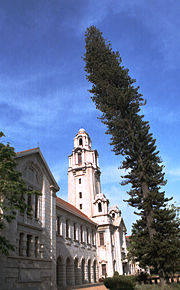
Till the early 19th century, education in Bangalore was mainly undertaken in schools that were run by religious leaders and restricted to pupils of that religion. The western system of education came into vogue during the rule of Mummadi Krishnaraja Wodeyar when two schools were established in Bangalore. This was followed by a school established by the Wesleyan Mission in 1851 and the Bangalore High School which was started by the Government in 1858.
In the present day, schools for young children in Bangalore are mainly based on the kindergarten form of education. Primary and secondary education in Bangalore is offered by various schools which are affiliated to any one of the boards of education like the Karnataka state board, ICSE, CBSE, National Open School (NOS), IGCSE and IB. There are three kinds of schools in Bangalore viz. government (run by the government), aided (financial aid is provided by the government) and un-aided private (no financial aid is provided). After completing their secondary education, students typically enroll in Junior College (also known as Pre-University) in one of three streams— Arts, Commerce or Science. Upon completing the required coursework, students enroll in general or professional degrees.
Bangalore is also the home of the Bangalore University which was established in 1964. Around 500 colleges, having a total student strength of 300 thousand are affiliated to this university. The university has two campuses within Bangalore; Jnanabharathi and Central College.
Indian Institute of Science, Bangalore which was established in 1909 is the premier institute for scientific research and study in India. Bangalore is also the home of colleges like the National Law School of India University (NLSIU) which is one of the most sought after law colleges in India, Indian Institute of Management, Bangalore which is one of the premier management schools in India and the Indian Statistical Institute, which is one of the top schools of India in the fields of statistics, mathematics, economics, operations research and information science.
Sister Cities
 Minsk, Belarus.
Minsk, Belarus.  San Francisco, California, United States.
San Francisco, California, United States.  Cleveland, Ohio, United States.
Cleveland, Ohio, United States.  Kharkiv, Kharkiv oblast, Ukraine
Kharkiv, Kharkiv oblast, Ukraine

